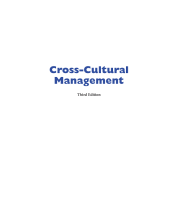Articles Summary
- This + 400k other summaries
- A unique study and practice tool
- Never study anything twice again
- Get the grades you hope for
- 100% sure, 100% understanding
Read the summary and the most important questions on Articles summary
-
4 Hofstede chapter 1
This is a preview. There are 21 more flashcards available for chapter 4
Show more cards here -
model of Kluckhohn and Strodtbeck - distinguishes communities
1.An evaluation of human nature (evil/mixed/good);
2.The relationship of man to the surrounding environment (subjugation/harmony/mastery);
3.The orientation in time (toward past/present/future);
4.The orientation toward activity (being/being in becoming/doing);
5.Relationships among people (individual/collective, collateral/hierarchy). -
5 Elenkov
This is a preview. There are 2 more flashcards available for chapter 5
Show more cards here -
leadership style - typology
crossing power distance and individualism -
motivational approaches - typology
crossing individualism and uncertainty avoidance -
performance appraisal systems - typology
crossing individualism and political influence -
strategic planning systems
crossing political influence and uncertainty avoidance -
6 Faure and Fang
This is a preview. There are 2 more flashcards available for chapter 6
Show more cards here -
ying yang perspective
used to capture the complexity of Chinese values -
7 janssens & brett
This is a preview. There are 7 more flashcards available for chapter 7
Show more cards here -
factors influencing creative realism in Global teams
- contextual factors (cultural precepts & unequal power)
- collaboration models (fusion, dominant coalition, integration/identity)
- teamwork task (information extraction, decision making)
creative realism - contextual factors (cultural precepts & unequal power)
-
unequal power among team members focus on both:
- power of a team member's unit in the global organization
- team member's fluency with the teams common language
- power of a team member's unit in the global organization
-
defining a fusion model of team collaboration
identifying compatibility of cultural precepts (replacing cultural precept/introducing new one/mixing) -
fusion approach to information extraction and decision making
1. information extraction: achieved by relying on multiple subgroups that reconstitute themselves in different configurations as the team's task changes
2. decision making: achieved by focusing on criteria of creativity and realism
- Higher grades + faster learning
- Never study anything twice
- 100% sure, 100% understanding
































